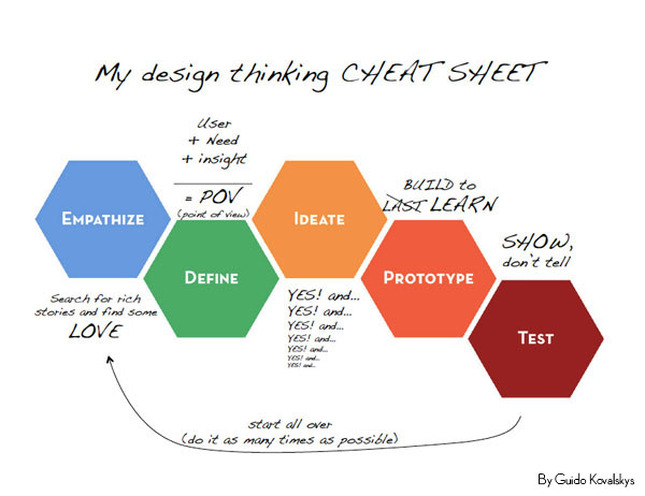
What is design thinking?
Design thinking is a relatively new way to go about problem-solving that focuses on doing. There are five steps:
1. Empathy - Meet with your clients/producers/end users and talk to them about the problem they think they have and any ideas they have for dealing with it. Try to put yourself in their shoes!
2. Define - Define the problem and try to broaden it. For example, if you've been told that the problem is that there's no well in a community, you can expand that - the problem isn't necessarily the lack of a well, but more broadly the lack of drinking water.
3. Ideate - Rather than thinking of "solutions" think of "ideas". Anything goes - crazy impossible, reasonable, likely, unlikely - you should record as many ideas as possible. Put it all on a board and then group them in different ways, pull different aspects from various ideas and put them together, and just generally be creative!
4. Prototype - Immediately put a few different ideas into action. The prototype is not supposed to be perfect, in fact, messier might be better because your goal is to get critical feedback from your users. The motto is to fail fast and fail cheap.
5. Test - Let people use the product, try out the experience, or otherwise interact with your prototype. Get their feedback and go back to the beginning!
The main point - rather than spending time trying to think out all the kinks in your head, just put something together and go with it, expecting to make improvements later.
This way of problem-solving definitely seems to have its advantages - it could lead to more creative solutions and a better, user-appropriate end product. It might also speed up the route to getting there by trying small things quickly and designing improvements quickly as well, rather than spending a longer time developing a big idea and producing it and then finding out it could have been improved in some way.
One example is the current race to design more heat-friendly protection suits for Ebola health workers in Liberia, Sierra Leone, and Guinea. Check out this article:
http://www.fastcoexist.com/3037375/can-better-design-stop-ebola-how-creative-minds-can-help
How could this be applied to the field of development?
Good question. Ideally, very localized development projects could go through these steps and discover the unique problems and solutions in each community, testing out a few different ideas along the way. Unfortunately, development tends not to work that way. Organizations and funders have specific areas of expertise or interest and that is what drives what they can do in a community, even if that doesn't necessarily correspond to people's expressed highest priority needs. For example, if a community really needs a public toilet, but the organization working there focuses on increasing participation in local politics, they are unlikely to provide a toilet. Equally, if an organization has received a grant to improve education in a community, which may happen before the organization is even on the ground where they'll be working, then they will be unable to respond to the need for job creation in that community. This is why grassroots, local organizations and workers can be really effective - they have effectively already gone through the empathy, define, and ideate phases and may just need funding/support for prototypes and testing. Organizations that have been working in one place for a long time should have this necessary background too.
Another issue is the quick and messy prototyping idea. This seems like something you wouldn't really want to try in a development situation where the product/system/service you're testing is supposed to be improving people's lives in some way, and may be expensive to put into place (i.e. a new toilet!). Much better to think it through properly first, right? However, a few cycles of verbal explanation and feedback may be a possibility to improve an idea before it's put into practice.
These were just some of my thoughts and the discussion my class had after the presentation. What do you think?
 RSS Feed
RSS Feed